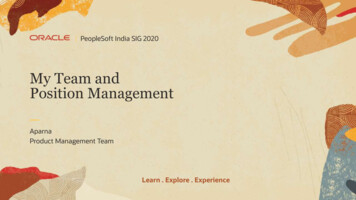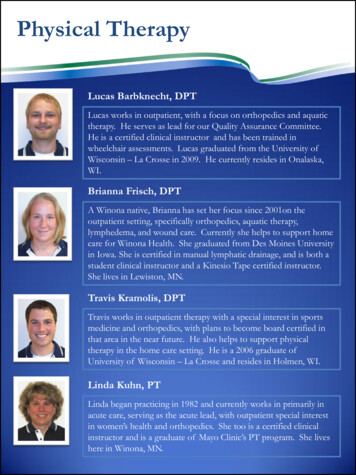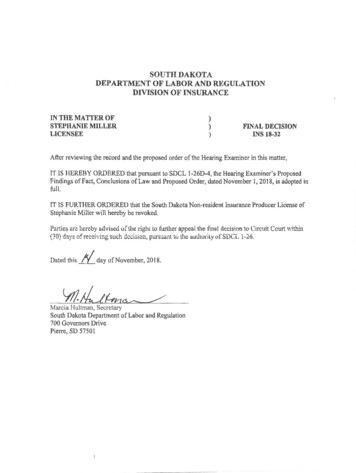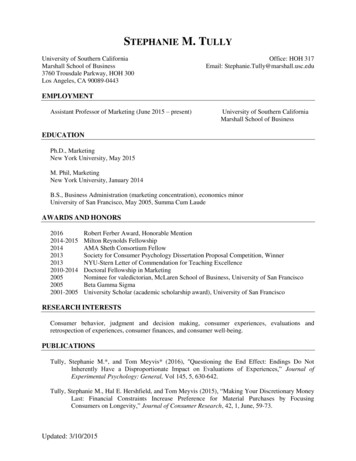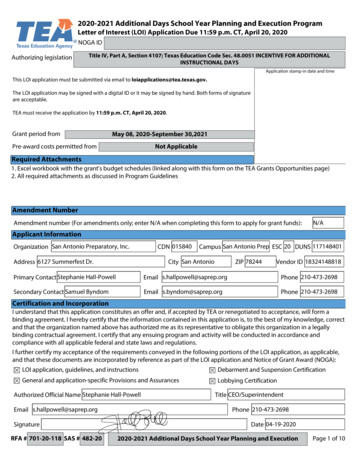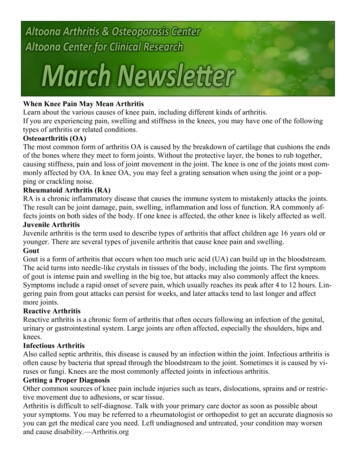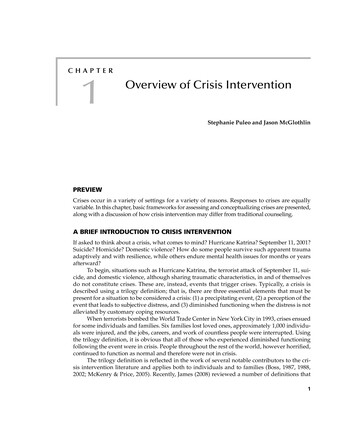
Transcription
CHAPTER1Overview of Crisis InterventionStephanie Puleo and Jason McGlothlinPREVIEWCrises occur in a variety of settings for a variety of reasons. Responses to crises are equallyvariable. In this chapter, basic frameworks for assessing and conceptualizing crises are presented,along with a discussion of how crisis intervention may differ from traditional counseling.A BRIEF INTRODUCTION TO CRISIS INTERVENTIONIf asked to think about a crisis, what comes to mind? Hurricane Katrina? September 11, 2001?Suicide? Homicide? Domestic violence? How do some people survive such apparent traumaadaptively and with resilience, while others endure mental health issues for months or yearsafterward?To begin, situations such as Hurricane Katrina, the terrorist attack of September 11, suicide, and domestic violence, although sharing traumatic characteristics, in and of themselvesdo not constitute crises. These are, instead, events that trigger crises. Typically, a crisis isdescribed using a trilogy definition; that is, there are three essential elements that must bepresent for a situation to be considered a crisis: (1) a precipitating event, (2) a perception of theevent that leads to subjective distress, and (3) diminished functioning when the distress is notalleviated by customary coping resources.When terrorists bombed the World Trade Center in New York City in 1993, crises ensuedfor some individuals and families. Six families lost loved ones, approximately 1,000 individuals were injured, and the jobs, careers, and work of countless people were interrupted. Usingthe trilogy definition, it is obvious that all of those who experienced diminished functioningfollowing the event were in crisis. People throughout the rest of the world, however horrified,continued to function as normal and therefore were not in crisis.The trilogy definition is reflected in the work of several notable contributors to the crisis intervention literature and applies both to individuals and to families (Boss, 1987, 1988,2002; McKenry & Price, 2005). Recently, James (2008) reviewed a number of definitions that1
2Part I Elements of Crisis InterventionCASE STUDY 1.1The NguyensVin and Li Nguyen are recent immigrants to the United States. They reside in a smalltown along the Gulf Coast of Mississippi, where a number of other Vietnamese immigrants have settled. Like many members of the community, the Nguyens are learning tospeak, read, and write English and are hoping to become naturalized citizens of theUnited States some day. After arriving in the United States, the Nguyens invested all oftheir money in an old shrimp boat in order to support themselves by selling their dailycatch to local seafood processing facilities.In 2005, the shrimp boat was heavily damaged, and the seafood processing facilities were destroyed by Hurricane Katrina. Subsequently, the Nguyens had no incomefor quite awhile. With limited income and no health insurance, they relied on thecounty department of public health for prenatal care when Li became pregnant. Li’spregnancy progressed normally; however, her daughter was born with Spina Bifida.As you read this chapter, try to conceptualize the Nguyens’ situation according tothe crisis models presented.Discussion Questions What incidents have occurred in the Nguyens’ lives that could be considered provoking stressor events? Beyond the provoking stressor events, are there additional stressors that theNguyens must address? What resources are the Nguyens utilizing? What further information do you needto determine if the Nguyens are in crisis? What factors will predict the outcome for this family?exist in the literature and summarized crisis as “a perception or experiencing of anevent or situation as an intolerable difficulty that exceeds the person’s currentresources and coping mechanisms” (p. 3).According to Slaikeu (1990), a crisis is “a temporary state of upset and disorganization, characterized chiefly by an individual’s inability to cope with a particular situation using customary methods of problem-solving, and by the potential for a radicallypositive or negative outcome” (p. 15). While it is always hoped that a positive outcome(McCubbin & Patterson, 1982) would occur, there are occasions when a radically negative outcome such as suicide happens, thereby precipitating further upset.FOUNDATIONS OF CRISIS INTERVENTION THEORYThe study of crisis intervention began in earnest during the 1940s in response to severalstressor events. During World War II, numerous families experienced distress andchanges in functioning after individual family members left home to participate in thewar effort. Families that seemed to experience the greatest degree of distress were thosethat had the most difficulty adapting to the absence of family members. Similarly, manyfamilies were forced to deal with losses brought about by a more acute stressor event, a
Chapter 1 Overview of Crisis Interventionnightclub fire that claimed nearly 500 lives in Boston, Massachusetts. These events led toHill’s proposal of a model through which family stress and crisis could be conceptualized and to Caplan and Lindemann’s proposed recommendations for responding tocrises at the community level. In the decades following the 1940s, these original modelshave been expanded, with more attention to contextual variables and to outcomes.Basic Crisis Intervention TheoryCaplan and Lindemann often are credited as pioneers in the field of crisis intervention.Their work began after a tragic event in Boston in 1942, the Cocoanut Grove nightclubfire, in which 493 people died. Lindemann treated many of the survivors of the nightclubfire and noted that they shared similar emotional responses, along with the need for psychological assistance and support (Lindemann, 1944). His work created awareness thatmany individuals who suffer loss experience pathological symptoms but have no specific psychiatric diagnosis. It was his contention that responses to sudden grief are normal and transient and need not be considered pathological. Lindemann theorized that“normal” responses to grief include preoccupation and identification with the deceased,feelings of guilt and expressions of hostility, disorganization in daily functioning, andsomatic complaints (Janosik, 1984). In essence, his paradigm for crisis interventionincluded an individual who was in a state of disorganization, brief therapy to assist theindividual in working through grief, and ultimately restoration of equilibrium.As Lindemann worked with others from Massachusetts General Hospital to assistsurvivors who had lost loved ones in the Cocoanut Grove fire, he began to realize thathelpers other than psychiatrists could assist people in coping with their sudden grief.Lindemann’s report describing common grief reactions to disaster, as well as the benefits of including clergy and other community helpers in intervention efforts, became acornerstone in the conceptualization of community mental health.Following the Cocoanut Grove fire, Lindemann worked with Caplan to establish acommunitywide mental health program in Cambridge, Massachusetts, known as theWellesley Project (Caplan, 1964). The aim of this project was to study and provide support to individuals experiencing traumatic events. The outcome of this project supported Caplan’s notion of preventive psychiatry—that is, early intervention in an effortto promote positive growth and well-being.Caplan (1961, 1964) expanded Lindemann’s concepts by expanding their application to a wider field of traumatic events. According to Caplan (1961), “People are in astate of crisis when they face an obstacle to important life goals—an obstacle that is, fora time, insurmountable by the use of customary methods of problem-solving. A periodof disorganization ensues, a period of upset, during which many abortive attempts atsolution are made” (p. 18). What is important to note in Caplan’s description is that theconcept of crisis refers to an outcome of a precipitating event, not to the precipitatingevent itself. Similar to Lindemann, Caplan described the outcome, or the crisis, as thestate of disequilibrium that the individual experiences.The ABC–X Model of CrisisHill (1949, 1958) was among the first to conceptualize a crisis theory that applied tofamilies. From his studies of families experiencing separation and reunion as a result ofWorld War II, Hill postulated the ABC–X Model of Crisis (see Figure 1.1). According to3
4Part I Elements of Crisis InterventionPerceptionEvent or SituationLowe ofDegre sHighStressisCriResourcesFIGURE 1.1 The ABC–X Model of Family Crisis.this model, there is an interaction among (A) a provoking stressor event, (B) the family’sresources, and (C) the meaning that the family attaches to the stressor event. The crisis(X), a state of acute disequilibrium and immobilization of the family system (Boss,1988), is an outcome of this interaction. Although Hill’s original research pertained tofamilies, the concepts he proposed may be applied to individuals.The Double ABC–X Model of CrisisHill’s original ABC–X model continues to provide a framework for much research in thearea of family stress and crisis; however, a few scholars (Boss, 1988, 2002; McCubbin &Patterson, 1982) have chosen to expand upon the model. Among the better-known variations of Hill’s work is the Double ABC–X Model of Crisis proposed by McCubbin andPatterson (1982). Writing from a systems orientation, which assumes that systems naturally evolve and become more complex over time, McCubbin and Patterson consideredrecovery and growth following crisis. The concept of adaptation was introduced todescribe lasting functional changes that occur in order to meet the demands of a crisisor stressful event. According to these scholars, Hill’s original model was somewhatincomplete in that it outlined only those factors that contribute to a crisis or breakdownin functioning. Following a state of disequilibrium or incapacitation, additional stressors may accrue, and additional resources may be identified and acquired.Subsequently, new perceptions that take into account the original event and relatedhardships or stressors, along with the application of resources and coping strategies tomeet the needs of those stressors, are formulated.According to McCubbin and Patterson (1982), there is a “double A” factor thatincludes Hill’s original concept of a provoking stressor plus the buildup of furtherstressors that must be addressed. These stressors may include unresolved issuesrelated to the crisis-provoking event, changes that occur unrelated to the event, andany consequences of attempts to cope (McKenry & Price, 2005). The “double B” factorrefers to resources available at the time of the provoking stressor, as noted by Hill,along with tangible and intangible resources that have been acquired or strengthened.Fortified coping resources would be included in this concept. The “double C” factor
Chapter 1 Overview of Crisis Interventionrefers not only to perceptions and meanings assigned to the original provoking stressorbut also to accumulated stressors, resources, coping, and the entire situation.Perceptions are influenced by religious beliefs, family and cultural values, and how thesituation may have been reframed. In the model proposed by McCubbin and Patterson,the original crisis (Hill’s X factor) constitutes a beginning point, while adaptation(“double X”) occurs later in time. Adaptation is an outcome variable involving changesin functioning and perception. More than the simple reduction of stress, adaptation isthe degree to which long-term change has occurred in response to the demands ofstressor and crisis events.Ecological and Contextual ConsiderationsIn addition to considering the accumulation of stressors and resources, Boss (1987, 1988,2002) and others (Collins & Collins, 2005) have suggested that stress and crisis are affectedby contextual factors. Collins and Collins (2005) have advocated a “developmentalecological” perspective to conceptualizing crises. According to these authors, some crisesare triggered by stressor events that are developmental in nature; that is, these developmental crises are expected events in the life span of the individual or family. However,regardless of whether the stressor event is developmental or situational, life span variablesmust be considered to determine their meaning and impact on the stress or crisis situation.In addition to considering developmental factors, Collins and Collins have maintainedthat the context provided by environmental factors such as interpersonal relationships,community resources, and society at large must be recognized. This approach suggeststhat each crisis is unique, since the ecological determinants for each person will be unique.Therefore, crisis counselors need to be aware that even though many of the clinical considerations and approaches may be similar for a specific crisis and for many individualsexperiencing that crisis (e.g., sexual assault), the person in crisis will experience the crisisdifferently than someone else due to the unique and personal ecological determinants. Inessence, do not simply generalize and implement a generic approach to a particular crisiswithout first assessing the client’s unique ecological factors.Boss (1987, 1988, 2002) similarly proposed a contextual approach to the study ofstress and crisis, stating that “factors in addition to the stressful event influence family vulnerability or breakdown” (2002, p. 28). According to Boss, stress is mediated bycontextual dimensions, which may be either internal or external. The internal contextincludes three dimensions that may be controlled or changed: the structure of thefamily, psychological elements such as perception and assessment, and philosophicalelements such as values and beliefs. The external context is composed of environmental or ecosystemic dimensions over which there is no control. External influences onstress and crisis include historical, economic, developmental, hereditary, and culturalcontexts.Elements of Stress and Crisis TheoryStressor events are those occurrences that provokechange in the functioning of a system. Stressor events may be positive or negative, andwhile some are normal and predictable, others are unforeseen. In general, stressorevents may be categorized as either normative stressor events (i.e., those stressors thatoccur at points of normal developmental transitions) or nonnormative stressor eventsPROVOKING STRESSOR EVENTS5
6Part I Elements of Crisis Intervention(i.e., products of distinctive, unexpected situations). Many families anticipate normative stressor events such as children graduating from high school and beginning college, while few anticipate nonnormative stressor events such as the school shootings atColumbine High School and Virginia Tech.Boss (1988) categorized stressor events and situations by source, type, and severity. Sources are either internal, originating within the family, or external, attributable tosomeone or something outside the family. Examples of internal stressors include partner violence and chemical dependency. These stressors begin within the family and areaccompanied by changes in the way the family functions. Partners and family membersoften adopt various roles, behaviors, and communication styles in attempts to copewith and survive the actions of the abusive or addicted person. As familiar copingstrategies become increasingly inadequate, families cease to function effectively andhealthily. “Crises” in these families are rarely a one-time occurrence (James, 2008).Another example of an internal stressor is infertility. Within the context of the family life cycle, most couples expect to be able to conceive and carry a pregnancy to term.Infertility is considered an internal stressor because the inability to achieve a successfulpregnancy originates with one (sometimes both) of the partners as opposed to something outside of the family. It becomes a crisis situation because the partners face psychological and relationship changes that affect the way they function. Each menses isencountered as a crisis situation. In response to this crisis situation, many couples areable to redefine their relationships and reframe their meanings of pregnancy and parenting; unfortunately, however, many couples do not respond well and ultimately separate (Puleo & Wilcoxon, 1995).External stressors originate outside the family but affect family functioningnonetheless. Examples of external stressors include natural disasters, terrorism, financial decline due to the stock market, and the rising cost of oil. Some external stressorsare attributable to forces of nature (e.g., hurricanes, tornadoes, earthquakes), some tohumans (e.g., violent crimes, job termination), and some to a combination of the two(e.g., global warming). Individuals and families typically have less control over externalstressors than they do over internal stressors. For example, families have little controlover the stock market. However, the ramifications of a declining stock market couldhave a substantial impact on a family’s future.As with internal stressors, however, the degree to which crises caused by externalstressors are experienced is contingent on available resources and the meaningattached to the stressor event. In the United States, Hurricane Katrina, an externalstressor, interrupted the normal functioning and triggered crises for thousands of families along the Gulf Coast of Louisiana, Mississippi, and Alabama. Families whoseemed to be the most resilient and who seemed to have the least difficulty recoveringfrom this crisis were those with available resources such as social support, housing,and financial assets.Many stressors are normal, predictable, and developmental in nature. Stressorevents of this type generally are an expected part of everyday life and of the family lifecycle. Typical normative stressor events include “birth, puberty, adolescence, marriage,aging, menopause, retirement, and death” (Boss, 2002, p. 51). Although these events areexpected, they have the potential to disturb the equilibrium of an individual or familyand result in crisis.
Chapter 1 Overview of Crisis InterventionThe type of crisis-inducing stressor that initially comes to mind for many peopleis the catastrophic, situational, unexpected event. Such a situation tends to be unique,is not predicted, and is not likely to be repeated. Examples of catastrophic stressorsinclude those that may be attributable to human behavior, such as the bombing of theAlfred P. Murrah Federal Building in Oklahoma City in 1995, or to natural disasters,such as the 2008 earthquake in China. Other nonnormative stressors may not becatastrophic at all, and may actually be positive, but nonetheless may still have thepotential to disrupt equilibrium. Examples are finding a lost relative (Boss, 2002) andwinning the lottery. Unexpected stressor events such as these also may be categorizedas nonvolitional stressors. Volitional stressors, on the other hand, are recognized by theamount of choice and control the individual or family has over them. Examplesinclude wanted changes in jobs or residences and planned pregnancies. Although volitional stressors are wanted and initiated, pursued, or orchestrated by the individual orfamily, they still have the potential to trigger a crisis if resources and meaning do notmatch needs and requirements. Changing jobs for the sake of career advancement, forinstance, may require a move to a geographic location where housing is unavailable orunaffordable. Even if everything goes according to plan (i.e., no medical complications, a single birth, and a healthy baby), financial and social support for a plannedpregnancy may be inadequate.Beyond classifying stressors by their source and type, Boss (2002) described stressorsituations according to their duration and severity. Some stressors are one-time events,happen suddenly, and resolve quickly; these are considered acute stressors. An automobile accident, for example, might disrupt a family’s equilibrium as broken bones heal andalternate transportation is used, but ultimately, the family’s balance is restored. Otherstressors, such as lifelong illnesses, infertility, and poverty, persist over long periods oftime and are considered chronic. Families caring for aging family members may experience chronic stress and may face disequilibrium and crisis each time the elderly familymember’s health takes a turn for the worse. The crisis is triggered by changes in healthbut is the result of additional demands for financial, social, and other resources as well asthe perception and meaning the family attaches to the elderly person’s decline. Finally,Boss (2002) suggested that it is important to consider whether a stressor situation is an isolated event or part of an accumulation of stressor events. It is often the case that any onestressor event may not be enough to trigger a crisis, but the cumulative effect of the pileupof stressors taxes resources, disrupts equilibrium and functioning, and results in crisis.RESOURCES Resources may be defined as traits, characteristics, or abilities that can beused to meet the demands of a stressor event (McCubbin & Patterson, 1982) and thatcan be available at the individual, family, or community level (McKenry & Price, 2005).They may be tangible (e.g., food, clothing, shelter) or intangible (e.g., social support,self-esteem). When resources are adequate to meet the demands created by a stressorsituation, the situation is less likely to be perceived as problematic—and less likely tolead to crisis. Two types of resources are important: those that are available and used tomediate the initial stressor and those that are acquired, developed, or strengthened subsequent to a crisis situation (McCubbin & Patterson, 1982). Individual resources mayinclude finances, education, health, and psychological qualities, whereas familyresources include the internal, systemic attributes of cohesion and adaptability, along7
8Part I Elements of Crisis Interventionwith resources such as financial management, communication skills, compatibility, andshared interests (Olsen, 1988). Community resources include external supports, such associal networks, on which the individual or family can draw.MEANING OR PERCEPTION Whether a stressor event results in crisis depends not onlyon available resources but also on the meaning attached to the event. The meaning attributed to a stressor event is subjective and comes from the way it is appraised throughboth cognitive and affective processes. Factors contributing to this qualitative variableinclude the ambiguity associated with the stressor situation, denial, and the belief andvalue orientation of the individual or family. Ambiguity occurs when facts cannot beobtained. It is often the case that specific information about the onset, development,duration, and conclusion of an unpredictable stressor event is unavailable. When information is unavailable, individuals may be uncertain in their perception of who isincluded in their families or social support systems. With limited understanding aboutwho is in and who is out, it becomes difficult to ascertain how various roles, rules, andfunctions will be carried out. Whereas sometimes stressors themselves are ambiguousbecause data are not available, at other times facts are available but are ignored or distorted. The resulting denial may be a useful coping strategy in the short term but may bedamaging if it prevents further action during a crisis situation (Boss, 1988, 2002;McKenry & Price, 2005).COPING In his original ABC–X model, Hill (1949, 1958) considered coping behaviors aspart of the family’s resources (represented by “B” in the ABC–X model) to be utilized inresponse to demands of a stressor event (“A”). While many researchers agree that coping behaviors are a subset of available resources, coping itself is a separate construct,often interacting with both resources (“B”) and perception (“C”). According to Pearlinand Schooler (1978), any effort taken to deal with stress may be considered coping.Thus, coping is a process and requires cognitive as well as behavioral activities(McKenry & Price, 2005; Pearlin & Schooler, 1978). Cognitively, people experiencingstressor events must appraise what is happening and assess any potential for harm.They also must evaluate the consequences of possible response actions. According toLazarus (1966, 1976), these appraisals occur before any coping mechanisms areemployed. Following appraisal, there are three types of coping responses that may beused: direct actions, intrapsychic mechanisms, and efforts to manage emotions. Directactions are those behaviors that typically are thought of as “fight or flight” responses.Examples include acquiring resources, asking for help, and learning new skills(McKenry & Price, 2005). These actions are used in relation to the environment in orderto master stressors and are thought of as problem-focused coping strategies.Emotion-focused coping strategies, conversely, involve mechanisms used tochange feelings or perceptions when there is little that can be done to change a stressor.Intrapsychic responses are those responses that often are thought of as defense mechanisms (e.g., denial, detachment) and allow people to alter their interpretations of thestress-provoking situation (Boss, 2002; McKenry & Price, 2005). Additional emotionfocused strategies are used to manage emotions generated by the stressor. Examplesinclude the use of resources such as social support or of alcohol and drugs. Obviously,specific coping responses are neither adaptive nor maladaptive; they are simply effortsto manage.
Chapter 1 Overview of Crisis InterventionCASE STUDY 1.1 (continued)The NguyensStressor events are those occurrences—positive or negative, predictable or unforeseen—that provoke change in the functioning of a system. They may be categorized as normative or nonnormative. The Nguyen family has experienced a number of provokingstressors, some of which they chose, others of which they did not.Stressors may be categorized by source, type, and severity and should be considered within context (Boss, 1988). There are many variables, such as culture, history, education, and heredity, over which the Nguyen family has no control. These compose theexternal context. Crisis counselors who work with the Nguyens need to take intoaccount their Vietnamese culture as well as additional cultural issues related to beingpart of an immigrant community along the Gulf Coast of the United States. Imbeddedin these considerations is the fact that the Nguyens chose to leave Vietnam for theUnited States some thirty years after the Vietnam War. What kinds of social prejudicesand biases does this couple face simply by being Vietnamese? Are there additionalbiases that they endure by virtue of being immigrants in a post-9/11 U.S. society?The Nguyens’ situation is complicated by their economic status, another component of their external context. Prior to Hurricane Katrina, they were making a living inthe shrimp industry. They had few bills and no debt; however, they had no medicalinsurance. On those rare occasions when they required medical attention, they wereable to use community public health resources. In the aftermath of Hurricane Katrinaand the tough economic times that followed, numerous public, nonprofit health agencies were forced to close their doors, making it difficult for the Nguyens to access prenatal care. When their daughter was born with a birth defect, they found it necessary totravel to a larger city to receive care for her needs. Thus, they incurred transportationand lodging expenses, further affecting their delicate economic status.Having lost their livelihood as shrimpers to Hurricane Katrina, the Nguyens wereforced to look for work elsewhere. They were fortunate in that they had a rather largesocial support network and that acquaintances helped them find employment onceretail outlets began to reopen in the months after the hurricane. Unfortunately, the retailjobs they found paid little more than minimum wages and did not include medicalinsurance. The Nguyens’ educational background and minimal fluency in Englishmade it difficult for them to pursue higher-paying jobs.Internal contextual factors are those that originate within the family and areaccompanied by changes in the way the family functions. The Nguyens chose to leavetheir family and friends in Vietnam in order to move to the United States. In doing so,the structure and definition of their family became less clear, particularly given the limited opportunities they had to return for visits. They also were forced to wrestle withissues related to caring for their aging parents. Once living in the United States, theNguyens’ family structure changed further when they became parents themselves.For the Nguyens, a relatively young couple, becoming parents could be considered a“normative” stressor. Normative stressors are normal, predictable, and developmental innature. This stressor of becoming parents also could be considered volitional, as a degreeof choice was involved. Conversely, nonnormative stressors are those that are unexpected.A catastrophic event such as Hurricane Katrina and all of its ramifications certainly should9
10Part I Elements of Crisis Interventionbe classified as nonnormative. For the Nguyens, having a child with Spina Bifida also is anonnormative and nonvolitional stressor, and its lasting implications will make its presence chronic.To ameliorate their situation, the Nguyens have several resources, derived fromboth internal and external contexts, on which they may rely. Although they left friendsand family behind in order to move to the United States, they are members of a fairlylarge immigrant community in Mississippi. From
2 Part I Elements of Crisis Intervention exist in the literature and summarized crisis as “a perception or experiencing of an event or situation as an intolerable difficulty that exceeds the person’s current resources and coping mechanisms” (p. 3). According to Slaikeu (1990), a cris




